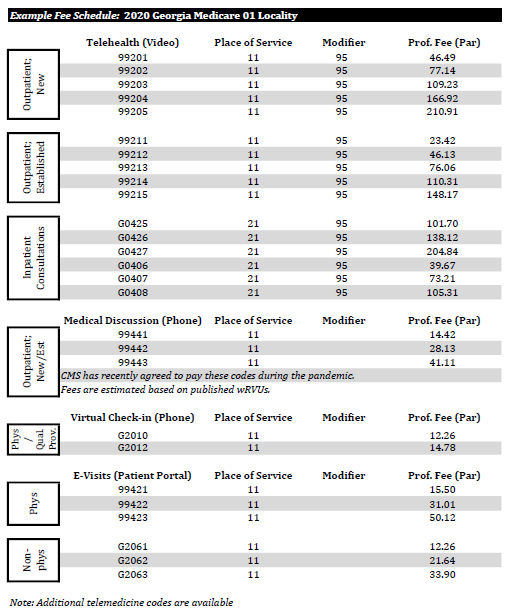Telemedicine/Telehealth
Revised April 9, 2020
Client Update: Telehealth, Virtual Check-in & E-visits
Medical Management Associates is studying the latest information regarding the COVID-19 pandemic and the impact on our clients every day and finding ways to help maneuver the current, changing environment. What we are hearing from our clients across the country:
- Our clients want to remain accessible to take care of their patients.
- Our clients are seeing many appointment cancellations and expect substantially reduced volume in the foreseeable future.
- Our clients are learning how to perform remote healthcare services - the information is complex and ever-changing.
Telemedicine is one way to take care of patients remotely. There are three key components to understand:
Getting Started
- Tell patients you're open for telemedicine visits.
- Use your website, social media, email, and patient portal.
- Use your marketing channels (e.g., Google ads).
- Update your phone message system, automated reminders, and scheduling scripts.
- Post a notice on the door of your practice.
- Call patients in advance of their scheduled appointment.
- Get the technology. Costs vary between vendors, as does their HIPAA compliance. During this time, HIPAA rules are being relaxed. A list of solutions is below:
- Check with your medical record vendor - some of them have technology built in.
- Telehealth may be conducted under the new rules using popular applications that allow for video chats, including Apple FaceTime, Facebook Messenger video chat, Google Hangouts video, or Skype
- Doxy.me - https://doxy.me/
- Skype for Business - https://www.skype.com/en/business/
- Updox - https://www.updox.com/
- VSee - https://vsee.com/
- Zoom for Healthcare - https://zoom.us/healthcare
- Physicians should not use Facebook Live, Twitch, TikTok or other public facing communication services.
- Schedule and staff the visits to make sure that providers are available to provide these virtual visits.
- Obtain consent from the patient about the tele-visit. Verbal consent is acceptable at this time.
- If applicable, you need to be able to e-prescribe. Note that controlled substances may still require paper prescriptions. Refer to state guidelines for prescriptive authority.
Coding and Reimbursement
(Video Conference Visits, Phone-based Care, and Online Check-ins)

- Document the visit in the medical record. You'll have to meet the requirements for the code selected. Document the patient consent.
- Medicare has updated its policies to broaden the scope of its payments. There is variation in what other carriers are saying at this time.
- Medicare is allowing Telehealth (video) visits to be provided when a patient is at home, not just in rural areas, effective March 6, 2020.
- New and established patients can be seen by telemedicine at this time. Medicare is not enforcing the requirement that an established patient relationship exists.
- You can bill for telemedicine visits based on the following guidelines:
- Telehealth Visit: If by real-time video conference you can bill E&M codes. Inpatient and outpatient visits apply. The rules have changed about where this is delivered.
- 99201-99215
- G0425-G0427
- G0406-G0408
- Phone Visits: Medicare has now agreed to cover medical discussions with a qualified provider by phone. Use codes 99441-99443.
- Virtual Check-in: Often by phone, use codes G2010 or G2012.
- E-Visit: Brief evaluations initiated by the patient through the patient portal are likely an E-Visit. Use codes 99421-99423 and G2061-G2063.
- Telehealth Visit: If by real-time video conference you can bill E&M codes. Inpatient and outpatient visits apply. The rules have changed about where this is delivered.
- Co-pays and deductibles may apply. Some carriers are waiving co-pays and deductibles at this time.
Liability
- HIPAA
- Effective immediately, OCR has announced "enforcement discretion" as it relates to HIPAA and telehealth remote connections during the pandemic.
- The "relaxed" regulations apply to all evaluations, not just COVID-19.
- Professional liability coverage
- Let your carrier/broker know you plan to perform these services and verify coverage.
- Stay within your scope of practice and license.
- Keep up to date regarding the ability to cross state lines when seeing patients.
- Consent the patient. At minimum, document a verbal consent.
There is little doubt that telemedicine services are limited in their scope and will not completely replace the need for face-to-face encounters. Information during the pandemic and after will change rapidly as you find new ways to take care of your patients.
For additional information and answers to your specific questions, please contact MMA at 770-951-8427.
Printable Version - MMA's Telemedicine Guide
Print the information on this page.
Supporting Documents
- Telehealth for New Patients - March 22, 2020
- Telehealth Coverage Policies - Center for Connected Health Policy/Public Health Institute - March 16, 2020
Coding Documents
- Billing for Telehealth Encounters - Center for Connected Health Policy/Public Health Institute - January 2020
- Centers for Medicare & Medicaid Services - Summary of Telemedicine Services Chart
Payer Telemedicine Policies
- Medicare Telehealth FAQs - March 17, 2020
- HHS Office of Inspector General Fact Sheet - March 2020
- HHS Office of Inspector General Policy Statement - March 17, 2020
- HHS Notification of Enforcement Discretion - March 17, 2020
- Medicare Healthcare Provider Fact Sheet - March 17, 2020
- Georgia Department of Community Health - Division of Medicaid - January 1, 2020
- Aetna - March 18, 2020
- Anthem BCBS - March 18, 2020
- Cigna - March 18, 2020
- Humana - March 18, 2020
- United Healthcare - March 18, 2020
- United Healthcare Medicare Advantage - March 18, 2020

